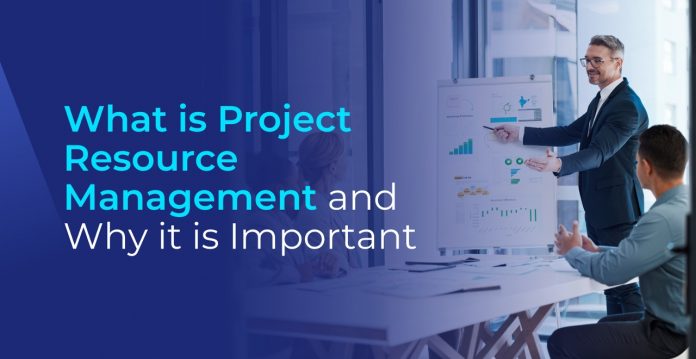
Managing resources effectively within a project is a challenge for many project managers. This is where project resource management comes into play. Project resource management is a crucial discipline within the project management realm; it encompasses the strategic planning, scheduling, and allocation of resources to ensure projects are completed on time, within budget, and to quality standards.
It is not merely a checklist of tasks; it’s a strategic approach that empowers project managers to navigate the complexities of resource allocation, maximizing productivity, and minimizing risks. Through proactive planning, careful monitoring, and continuous adaptation, project managers can harness the power of their resources to steer projects toward success.
This article explains everything about project resource management from scratch, including its importance, types of resources, techniques, and best practices.
Before going deeper into the topic, let’s discuss what is Resource Management in Project Management?
Table of Contents:
- What is Project Resource Management?
- What is a Resource in a Project?
- Importance of Project Resource Management
- Types of Resources in Project Management
- What Are the Steps Involved in Project Resource Management?
- Project Resource Management Techniques
- Best Practices for Project Resource Management
- Conclusion
What is Project Resource Management?
Project resource management (PRM) is one of the major aspects of project management and involves managing resources required to complete a project. It involves identifying and assessing resource needs, developing a resource plan, scheduling resources, tracking and monitoring resource usage, and managing resource conflicts.
Resource Management is a crucial aspect of project management, as it can improve project outcomes, reduce project costs, increase project efficiency, and mitigate project risks. It involves a variety of activities, including:
- Identifying and assessing resource needs
- Developing a resource plan
- Scheduling resources
- Tracking and monitoring resource usage
- Managing resource conflicts
The goal of Project Resource Management is to ensure that resources are utilized efficiently, that the right people are assigned to the right tasks, and that potential challenges, such as unforeseen circumstances or resource shortages, are proactively addressed.
The resource management also ensures that project teams are equipped with the necessary resources for project completion and ensures optimal resource utilization.
By employing effective resource management techniques, project managers can confidently ensure the fulfillment of project requirements and the successful completion of their projects.
What is a Resource in Project Management?
In the context of project management, a resource encompasses any element required to execute project tasks and bring a project to completion.
A proper resource management ensures efficient resource planning and scheduling encompass reusable human resources, such as skilled personnel and their expertise, and non-human resources, such as computers, equipment, and facilities.
By meticulously managing these resources, you can optimize their utilization, adhere to project timelines and budgets, and enhance team performance. This optimization can reduce overtime, minimize stress, and maximize team potential.
Effective resource management is crucial for the success of any project. Identifying, securing, and utilizing resources are key aspects of successful project management, as each resource plays a vital role in contributing to the overall project outcomes.
Importance of Project Resource Management
Project resource management is advantageous as it establishes a solid foundation for success. It offers a systematic framework for contemplating staffing considerations and strategizing the optimal utilization of human resources.
This ensures you and your team can deliver the project to the best of your capabilities, considering the interdependencies and constraints inherent in the project environment. An effective Project Resource Management offers numerous benefits that contribute to the overall success of projects:
1. Optimizes Resource Utilization
Project resource management ensures that resources are allocated efficiently and effectively, preventing underutilization and waste. By matching the right resources to the right tasks, project managers maximize the productivity and output of each resource.
This optimization leads to improved project outcomes and reduced costs.
2. Enhances Project Efficiency
The resource management streamlines resource allocation and scheduling, ensuring that resources are available and tasks are completed without delays or bottlenecks.
This streamlined approach minimizes disruptions and promotes a smooth project workflow, ultimately enhancing project efficiency.
3. Reduces Project Costs
Project Resource Management helps prevent resource waste and underutilization, which directly translates to cost savings. Project managers can optimize resource allocation and scheduling to minimize unnecessary expenses and keep project costs within budget.
4. Mitigates Project Risks
Project resource management involves identifying and addressing potential resource constraints, such as skill shortages or equipment limitations before they hinder project progress.
By proactively addressing these constraints, project managers can reduce the likelihood of project delays, setbacks, or even failures.
5. Improves Project Outcomes
Effective Project Resource Management contributes to the overall success of projects by ensuring that resources are available when needed, tasks are completed efficiently, and potential risks are mitigated.
This leads to improved project outcomes, including timely completion, adherence to budget, and delivery of high-quality deliverables.
Enroll in industry recognized Project Management certification courses at Invensis Learning and master project mangement skills!
Types of Resources in Project Management
Project management recognizes seven primary resource types: services, labor, equipment, materials, money, time, and space. Each type possesses distinctive characteristics and demands efficient management to guarantee project success.
The seven fundamental types of resources in project management are mentioned below in detail:
1. Services
Services represent the expertise and specialized skills provided by external vendors or contractors. These services range from technical consulting and software development to legal counsel and marketing expertise.
Project managers often engage external service providers to fill gaps in their team’s expertise, gain access to specialized skills, or handle specific tasks that require specialized knowledge or resources.
Examples of services in project management:
- IT consulting and software development
- Marketing and advertising services
- Legal counsel and regulatory compliance
- Training and coaching services
- Translation and interpretation services
2. Managing Labor as Resources in Project
Labor refers to human resources, including the project manager, team members, and any external personnel involved in project activities. The project team’s skills, expertise, and experience are crucial for planning, executing, and monitoring project tasks.
Effective labor management involves recruiting, hiring, training, motivating, and retaining the right people with the necessary skills to deliver project deliverables.
Examples of labor in project management:
- Project managers and team members
- Skilled tradespeople and technicians
- Designers, engineers, and architects
- Sales and marketing personnel
- Customer support representatives
3. Equipment Resource Management
Equipment encompasses the physical assets necessary to carry out project tasks. This could include computers, software, construction equipment, office supplies, or specialized machinery. Ensuring these resources availability and proper utilization is essential for project efficiency.
While managing resources for a project, Project managers must plan for equipment needs, procure it, and ensure it is properly maintained and used safely.
Examples of equipment in project management:
- Computers, laptops, and tablets
- Software applications and tools
- Construction machinery and tools
- Office furniture and equipment
- Laboratory equipment and testing tools
4. Materials
Materials represent the raw components that are transformed into project deliverables. This could include lumber, concrete, steel, software code, or any other tangible elements that form the basis of the project’s output.
Effective procurement and management of materials are crucial for project progress and quality control. Project managers must plan for material needs, ensure timely delivery, and manage inventory levels to avoid shortages or surpluses.
Examples of materials in project management:
- Construction materials (lumber, concrete, steel)
- Manufacturing components (electronics, textiles, chemicals)
- Software code and programming languages
- Marketing materials (brochures, signage, promotional items)
- Training materials and documentation
5. Money Resource Management
Financial resources represent the monetary funds required to execute the project. This includes salaries, wages, material costs, travel expenses, and other financial obligations incurred during the project lifecycle.
Prudent financial management ensures that the project stays within budget and that resources are allocated effectively. Project managers must develop and monitor project budgets, track expenses, and maintain cash flow to ensure financial stability and project success.
Examples of financial resources in project management:
- Salaries and wages for project team members
- Material costs and procurement expenses
- Travel costs and accommodation for project staff
- Software licenses and subscription fees
- Equipment rental or purchase costs
6. Space
Physical space, whether an office, a construction site, or a virtual environment, is crucial for project activities. It provides a platform for team collaboration, task execution, and storage of equipment and materials.
Effective space management ensures that project activities can be carried out efficiently and safely. Project managers must assess space needs, plan for workspace allocation, and ensure that the project environment is conducive to productivity and safety.
Examples of space resources in project management:
- Office space for project team members
- Construction sites for physical projects
- Virtual meeting rooms and collaboration platforms
- Storage facilities for equipment and materials
- Laboratories and testing facilities
7. Time
Time is a finite and irreplaceable resource in project management. It represents the duration available to complete project tasks and deliver the project’s outcomes.
Effective time management involves careful scheduling, task prioritization, and resource allocation to ensure that projects are completed on time without compromising quality.
Project managers must develop project schedules, monitor task progress, and manage risks that could impact project timelines.
Examples of time management in project management:
- Developing and maintaining project schedules
- Prioritizing tasks and managing task dependencies
- Tracking task progress and identifying potential delays
- Managing risks that could impact project timelines
- Communicating project timelines to stakeholders
What Are the Steps Involved in Project Resource Management?
1. Plan Resource Management
Effective project resource management begins with a well-structured plan that lays the groundwork for seamless resource allocation and utilization throughout the project lifecycle. This planning phase encompasses:
- Identifying Resource Needs: Accurately determine the type, quantity, and timing of resource requirements for each project task. Consider project scope, timeline, budget, and skill/equipment needs
- Developing a Resource Plan: Create a comprehensive plan that outlines how resources will be allocated to project tasks. Match skills to tasks, schedule equipment usage, and plan material procurement
- Establishing Resource Management Processes: Define clear processes for resource allocation, scheduling, monitoring, and adaptation to ensure consistent and effective resource utilization
2. Estimate Activity Resources
Accurate resource estimation is crucial for effective allocation and scheduling. This involves:
- Analyzing Task Requirements: Break down project tasks into constituent elements and identify the specific resources needed for each step
- Quantifying Resource Needs: Determine the quantity of each resource required, considering factors like task duration, resource utilization rates, and potential contingencies
- Estimating Resource Availability: Assess the availability of resources, including internal personnel, external contractors, equipment, and materials, to ensure resource needs can be met
3. Acquire Resources
With clear resource requirements in hand, project managers must procure the necessary resources to support project execution. This entails:
- Identifying Resource Sources: Determine the sources for acquiring resources, such as internal recruitment, external contracting, equipment rentals, or material procurement
- Initiating Acquisition Processes: Initiate the necessary procedures to acquire resources, including issuing purchase orders, hiring personnel, or contracting external vendors
- Managing Resource Acquisition Timeline: Closely monitor the acquisition process, ensuring that resources are secured on time to avoid project delays
4. Develop Team
A strong and cohesive project team is essential for effective resource utilization. This involves:
- Team Formation: Select team members with the necessary skills, experience, and expertise to match the specific requirements of project tasks
- Team Building: Foster a collaborative and supportive team environment that promotes teamwork, communication, and knowledge sharing
- Team Training: Provide adequate training and development opportunities to ensure team members have the necessary skills and knowledge to perform their tasks effectively
5. Manage Team
Effective team management ensures that resources are utilized optimally and that team members are motivated and productive. This involves:
- Performance Management: Establish clear performance expectations and provide regular feedback to team members to improve their performance and contribution
- Motivation and Engagement: Foster a positive and motivating work environment that keeps team members engaged, committed, and invested in the project’s success
- Conflict Resolution: Address any conflicts or disagreements that arise within the team promptly and effectively to maintain a harmonious and productive team dynamic
6. Control Resources
Continuous monitoring and control are crucial to ensure that resources are utilized efficiently and effectively within the project lifecycle. This involves:
- Tracking Resource Usage: Monitor resource utilization rates, including time spent on tasks, equipment usage, and material consumption
- Identifying Resource Bottlenecks: Identify potential resource bottlenecks or conflicts that could impact project progress and take proactive measures to address them
- Adapting Resource Allocation: Continuously evaluate resource needs and adapt resource allocation as project dynamics evolve to ensure optimal resource utilization
Project Resource Management Techniques
Effective project resource management (PRM) involves various techniques and strategies to ensure that resources are utilized efficiently and effectively throughout the project lifecycle.
These techniques help project managers optimize resource allocation, minimize resource waste, and maximize productivity, ultimately contributing to project success.
1. Resource Allocation
Resource allocation is the process of assigning resources to specific tasks or activities within a project. This involves matching the right resources with the right tasks and ensuring that the skills, experience, and equipment requirements of each task are met.
Effective resource allocation is crucial for maximizing resource utilization, minimizing waste, and optimizing project outcomes. Key considerations for resource allocation:
- Resource Availability
- Resource Skills and Experience
- Resource Utilization
2. Resource Aggregation
Resource aggregation is the process of grouping similar resources for more efficient management and allocation. This can involve grouping resources by type (e.g., software developers, engineers, designers), skill level (e.g., junior, mid-level, senior), or experience (e.g., project-specific, industry-specific).
Resource aggregation simplifies resource management, facilitates skill sharing, and enables project managers to identify and deploy resources with the necessary skills quickly. Benefits of resource aggregation:
- Improved Resource Visibility
- Enhanced Skill Sharing
- Efficient Resource Allocation
3. Resource Scheduling
Resource scheduling is the process of determining when resources will be needed throughout the project lifecycle. This involves creating a detailed project schedule that outlines each task’s start and end dates, ensuring that resources are available at the right time to support project progress.
Resource scheduling helps identify potential resource bottlenecks and conflicts, allowing for proactive adjustments. Key considerations for resource scheduling:
- Task Dependencies
- Resource Availability
- Resource Conflicts
Best Practices for Project Resource Management
Achieving project success relies heavily on effective Project Resource Management, which involves planning, allocating, and optimizing resources throughout the project lifecycle.
By adopting best practices in this crucial aspect of project management, organizations can enhance their ability to deliver optimal results.
The following outlines key best practices for Project Resource Management:
- Know Your Team’s Capabilities: Understand your team’s strengths and limitations to assign tasks effectively and optimize resource usage
- Using a Work Breakdown Structure (WBS): Implement a WBS to break down tasks systematically, aiding accurate planning and resource allocation
- Avoid Resource Overloading: Distribute tasks evenly to prevent burnout, maintain quality, and ensure realistic project timelines
- Keep Clear Communication: Foster transparent communication to convey project goals, expectations, and changes, promoting collaboration
- Focus on Your Critical and Valuable Resources: Prioritize critical resources for high-impact tasks to maximize their effectiveness
- Track Actual Time Spent on Tasks: Monitor and record actual time spent on tasks for insights into resource efficiency and continuous improvement
Conclusion
Project Resource Management stands as the foundation of successful project completion, meticulously orchestrating the strategic deployment of human, material, financial, and time resources. Through a deep understanding of its nuances, we have recognized that effective resource management is not just a logistical requirement but a fundamental driver of project success.
By embracing best practices and navigating the systematic steps involved, project managers can not only guarantee the smooth execution of tasks but also proactively manage risks, optimize team performance, and play a pivotal role in the timely attainment of project objectives.
Elevate your project management expertise and propel your career forward with Invensis Learning’s Project Management Certification courses. Gain industry-recognized credentials, enhance earning potential, and become a sought-after project management professional. Enroll today and embark on a transformative journey towards project management mastery.














